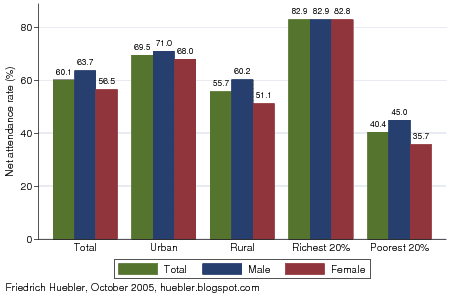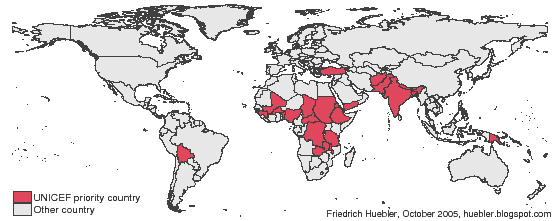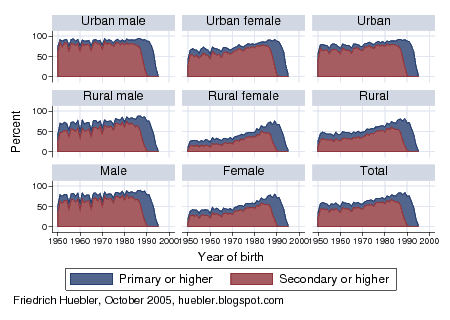The most recent data on school attendance in Nigeria comes from a Demographic and Health Survey (DHS) that was conducted in 2003. 60.1% of all children of primary school age were attending primary school at the time of the survey. Boys had a higher net attendance rate (NAR) than girls, with 63.7% compared to 56.5% for girls.
Primary school net attendance rate, Nigeria 2003

Data source: Nigeria 2003 DHS.
Children in urban areas had a higher primary NAR (69.5%) than children in rural areas (55.7%). The disparity between children from the richest and poorest households was even greater. In the richest 20% of all households, 82.9% of all children of primary school age attended primary school. In the poorest 20% of all households only two out of five children were in school (primary NAR 40.4%).
A comparison of the male and female NAR reveals that there was no gender disparity in the richest households. In urban areas, the difference between male and female NAR was also relatively small, with a gender gap of just 3.1%. In rural areas and among the poorest 20% of all households, girls were far less likely to attend school than boys; in both cases, the primary NAR of girls was about 9% below that of boys.
Primary school net attendance rate, Nigeria 2003
| Total NAR (%) | Male NAR (%) | Female NAR (%) | Difference male- female | GPI female/ male | |
| Urban | 69.5 | 71.0 | 68.0 | 3.1 | 0.96 |
| Rural | 55.7 | 60.2 | 51.1 | 9.0 | 0.85 |
| Richest 20% | 82.9 | 82.9 | 82.8 | 0.1 | 1.00 |
| Poorest 20% | 40.4 | 45.0 | 35.7 | 9.3 | 0.79 |
| Total | 60.1 | 63.7 | 56.5 | 7.2 | 0.89 |
Related articles:
- Secondary school attendance in Nigeria
- Age and level of education in Nigeria
- Household wealth and school attendance in Nigeria
Friedrich Huebler, 31 October 2005 (edited 21 January 2006), Creative Commons License


